RENEGADE GARDENER™
The lone voice of horticultural reason
The 2008 Renegade Gardener High Spot / Black Spot Awards
 |
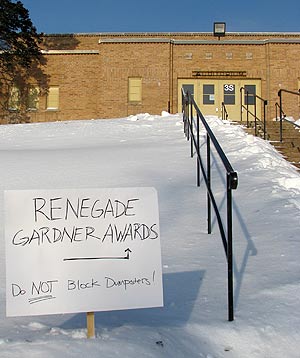 |
01-01-09/Angle Inlet, MN — A hearty and hardy “hello” from the top of America, Angle Inlet, Minnesota! Live from the spacious, semi-festooned Angle Inlet High School Auditorium, welcome to the 9th Annual Renegade Gardener High Spot/Black Spot Awards!
Outside, the temperature is a stunningly frigid twenty-nine degrees below zero, while here inside the auditorium it’s, well, fifty-six degrees, and as tonight’s presenters, recipients, audience, and celebrity guests arrive, you wouldn’t believe the language! More schnapps!
We have a minute to play with here, as many of the guests are still being whisked off the frozen Lake of the Woods by snowmobile, 4-wheel ATV, and float plane ambulance, following the bitter conclusion of this afternoon’s 1st Annual Renegade Gardener Celebrity ProAm Ice Fishing Contest, won by Duluth nurseryman Ingmar Lindquist.
Ingmar is well known across these parts for the fortune he made in the ‘70s when he developed the first hardy Zone 2 cactus, Cephalocereus stagnantis ‘Wonder,’ a fortune he lost in the ‘80s when it was discovered the twelve-inch cacti were actually manufactured from a boiled concoction of candle wax and muskrat fur that Ingmar and his brother, Dolph, were pouring into small wooden molds and spray painting green. Says Ingmar with a laugh, “Da ‘wonder’ wos dat it took so long fer da pipple to figger out why dey stayed da same size fer ten yierce!” Gotta love a big, honest Swede!
 |
| The survivors of the Celebrity ProAm Ice Fishing Contest. Back L-R: Karl Foerster, Dan Heims, Dale Earnhardt Jr., Ingmar Lindquist, Justin Hancock. Front L-R: Jeff Gillman, The Renegade, Kent Hrbek, Carl Linnaeus, Craig Black. |
 More coal! Crank up the boiler, butts down in your seats, cue the Angle Inlet Fighting Eelpout Pep Band, and let’s start giving out some awards!
More coal! Crank up the boiler, butts down in your seats, cue the Angle Inlet Fighting Eelpout Pep Band, and let’s start giving out some awards!
High Spot Award
Gardener of the Year: Bono
Statesman, conservationist, social organizer and savior, Bono’s credentials as lead singer for an Irish rock ‘n’ roll band can never be overstated. So masterful are his gardening skills that here, planting a tree with children in Tokyo, he not only completes the task without causing a speck of dirt to sully the spade, he does it while holding the tool exactly backwards. No doubt the time is not far off when Bono will be able to plant trees using merely the power of his mind, while still remaining focused enough to not blow the pose for the photo-op.
High Spot Award
Best Gardening Book of the Year: PLANTHROPOLOGY
The Myths, Mysteries, and Miracles of My Garden Favorites
by Ken Druse (Clarkson Potter)
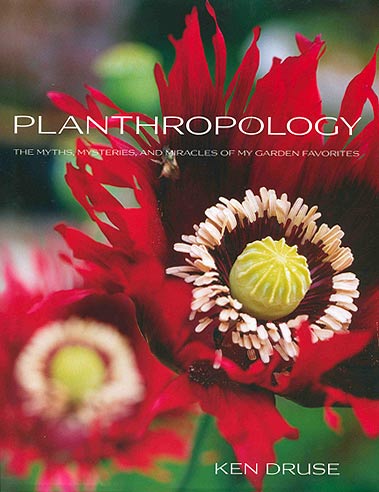 Oh yes, yes, yes, just in time for the winter gardening book list, just in time for Blizzard Sundays (as we call any winter day in Minnesota where you’d go cross-country skiing if the snowdrift on the other side of the door would allow you), and just in time to ease my cynical mind and callous heart: A new book by gardening’s Godfather, Ken Druse.
Oh yes, yes, yes, just in time for the winter gardening book list, just in time for Blizzard Sundays (as we call any winter day in Minnesota where you’d go cross-country skiing if the snowdrift on the other side of the door would allow you), and just in time to ease my cynical mind and callous heart: A new book by gardening’s Godfather, Ken Druse.
What a great gig. Here, Ken, come up with a list—a long list—of the plants you grow, cherish, and admire, then write a book—a big book—with captivating stories about their history and development, their use and care, their blatant beauty and dirty little secrets. And while you’re at it, shoot the photos as well, hundreds of them, since your eye with a camera is equaled only by your wizardly way with words.
Sorry, am I gushing? Yes. For a garden writer, reading Ken Druse is like a sixteen-year-old guitar player watching Eric Clapton in concert. The pace is impeccable, every note is perfect, and jeez Louise, how did he just do that?
Stories from Ken’s earliest childhood memories of his mother’s garden are juxtaposed seamlessly with tales of Captain James Cook in the 1700s. Or you may find yourself back 10,000 years, visiting our ancestors while they start domesticating livestock and cultivating the grasses to feed them. Within a few pages you meet Pythagoras, the ancient Greek philosopher; Fibonacci, the 13th-century mathematician, and of course, Leonardo da Vinci—scientist, painter, draftsman, engineer, inventor. What do they have in common? Your garden.
As compelling as a crime novel, Planthropology just so happens to dispense more useful gardening wisdom along the way than half the books on my shelf. Whatever the topic—garden art, fragrance, bloom color, pests, pruning, propagation, design, bees, butterflies, several dozen more—Druse’s great gift as a writer has always been foremost that the reader not only learns, but learns in proper context, his words a loving and playful kick in the pants toward lasting appreciation.
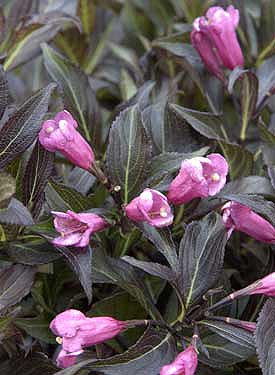 High Spot Award
High Spot Award
Shrub of the Year: Weigela florida ‘Dark Horse’
As gardeners stagger through the five- to fifteen-year process whereby they discover that garden design means more than growing perennials in beds and annuals in pots, the crooked pathway leads them to the wonderful world of shrubs. Venturing further upward from this essential plateau, hopefully they encounter a good nursery with a goodly supply of one of the grandest of all blooming shrubs, Weigela.
‘Dark Horse’ is a new introduction that further exemplifies the fine work in genetic modification that is giving us Weigelas of a more dwarf and compact nature. Approaching only 3’ H x 3’ W at maturity, ‘Dark Horse’ is ideal for foundation plantings under windows and is a dazzling understory shrub when used with larger shrubs and trees. Profuse clusters of magenta-pink flowers burst forth in June, and really pop out against the dark purple-bronze foliage with killer, contrasting lime-green veining.
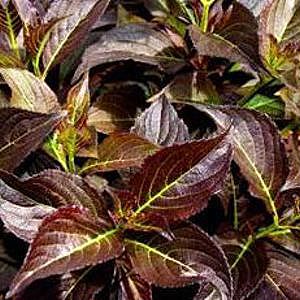 Plants require full sun for full blooming, though the nice thing about these newer, dark-leaved Weigelas is that the foliage color stays true in part shade. Truly hardy to Zone 4, ‘Dark Horse’ is a good replacement for the less-than-stellar ‘Midnight Wine.’
Plants require full sun for full blooming, though the nice thing about these newer, dark-leaved Weigelas is that the foliage color stays true in part shade. Truly hardy to Zone 4, ‘Dark Horse’ is a good replacement for the less-than-stellar ‘Midnight Wine.’
Black Spot Award
Pleasant Trend Inexorably Turns Nightmarish: Extremists in the Locavore Movement
Restaurants preparing locally grown food is a wonderful concept, and an even better reality, where enhanced flavors due to freshness coupled with reduced energy consumption from transport provide a real benefit to businesses and consumers. At the grocery store or farmer’s market, buying produce, dairy products and meats grown and raised nearby, while hardly a brand new opportunity, is also a simple choice that makes sense.
Of course, it wasn’t long before a small but vocal portion of Americans embraced the “locavore” movement and proclaimed it as the perfect solution to every food supply and energy consumption ill. Often entwined with other extremists from the organic food and animal rights brigades, they wonder how anyone could be so stupid as to not join them in envisioning a future society where each neighborhood diligently grows its own food and purchases what it can’t at nearby markets, supplied by small farmers who raise happy pigs and free-range chickens on the outskirts of town.
Well, humans tried that. It was called The Middle Ages, and if that had remained our food production modus operandi, there wouldn’t be any humans left on the planet to attempt it a second time (much to the pleasure, however ephemeral, of the animal rights extremists). Veering toward that model today would certainly result in massive loss of human life, considering how a global food market is necessary to provide food for those who—due to arid, infertile land and/or corrupt governments—cannot provide it for themselves. It also flies in the face of the fact that farmers, American and beyond, rely heavily on exporting in order to earn a living.
So to the happy, realistic locavores of America—thumbs up. It’s a fine option, and if my choices of locally grown foodstuffs available at my nearby markets increase in the future, hey, all the better. But I also maintain my freedom to splurge on Florida oranges, California asparagus, Belgian chocolates and Danish sugar cookies. I live in Minnesota, after all. Any of you ever tried Minnesota-raised foie gras? It’s terrible.
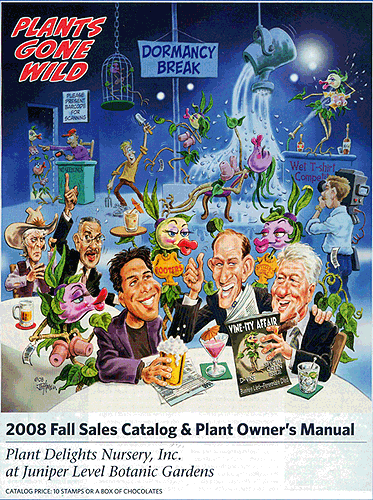 High Spot Award
High Spot Award
Best Plant Catalogue: Plant Delights Nursery
Hey you guys, are you hiring? I’ll move to Raleigh and work for free plants if I can ever be of service. People, gardening is supposed to be fun, remember? No bunch of plant purveyors I know seem to have more fun doing what they love than Tony, Candi, George, Dianne and the rest of the happy horticulturists at North Carolina’s wonderful Plant Delights Nursery.
It’s a fabulous perennial nursery and a fabulous mail-order catalogue, known for their robust product and great customer service. The perennials they offer are a near perfect blend of the standard and the unusual, dusted with just enough truly esoteric varieties that the catalogue keeps you flipping the pages for hours.
The judges were impressed by the great number of genera, yet the prudent number of varieties within most. I don’t like trying to choose between every Heuchera variety that’s come along since 1975, or 45 varieties of Geraniums. Part of the job of a good plant catalogue is to winnow it down for you, to offer plants that the nursery people behind the catalogue have tested and critiqued.
Great photos and plant descriptions, but of course, part of the fun is waiting to see what they’ll concoct for the covers of their annual spring and fall catalogues. To order, visit www.plantdelights.com.
High Spot Award
Bailey Nursery’s Two-Year Plant Warranty on Easy Elegance® Roses
 Just announced for 2009, St. Paul, Minnesota’s Bailey Nursery, creators of ‘Tiger Eye’ Sumac, ‘Endless Summer’ Hydrangea and numerous others, will offer consumers a full two-year warranty on their terrific line of Easy Elegance® shrub roses.
Just announced for 2009, St. Paul, Minnesota’s Bailey Nursery, creators of ‘Tiger Eye’ Sumac, ‘Endless Summer’ Hydrangea and numerous others, will offer consumers a full two-year warranty on their terrific line of Easy Elegance® shrub roses.
Nowhere in the industry that I’m aware is there a plant warranty that exceeds one year. Said a spokesperson for Bailey’s, “People think that if they grow roses it means growing grandma’s roses. We want them to know that growing shrub roses is not a scary thing. It’s like growing a spirea except the blooms are lovelier and it blooms longer.”
Starting this spring, consumers will find a Two-Year Warranty tag on every Easy Elegance rose. Assuming one doesn’t plant the thing in clay and water it once a year on the 4th of July, if the rose fails, you just return the tag with receipt directly to Bailey, and they’ll cut you a check.
It will be run on a straight honesty program. That’s how we do things in Minnesota.
Black Spot Award
Worst Gardening Website: The Home & Garden Pages of PETA.org
 After a wasted hour perusing the Home and Garden information pages of the website created by the People for the Ethical Treatment of Animals, about the only thing I learned about gardening is that the PETA founders would be smugly pleased if your garden, your neighbor’s garden, your state’s farm fields, and the planet’s entire food supply were completely obliterated by locusts.
After a wasted hour perusing the Home and Garden information pages of the website created by the People for the Ethical Treatment of Animals, about the only thing I learned about gardening is that the PETA founders would be smugly pleased if your garden, your neighbor’s garden, your state’s farm fields, and the planet’s entire food supply were completely obliterated by locusts.
Being an animal rights group, and then some, their home and garden section is a little sparse when it comes to advice on growing roses, but oh, do they have some novel ideas when it comes to insects and critters:
Ant Control: there are a few simple things that you can do to solve any perceived problems with these tiny beings without the need for toxic chemicals and cruel traps. A product called Orange Guard is a nontoxic organic ant repellent that is harmless to humans and other animals and will drive ants away from areas where they are not wanted. However, when applied directly to ants, the active ingredient d-Limonene (orange peel extract) destroys the waxy coating of the insects’ respiratory systems, causing the ants to suffocate, so please do not spray ants with the repellent.
It’s easy to see the corner that PETA members have painted themselves into. When you take the stand that humans shouldn’t kill animals, you have to take it all the way. Which means you can’t kill ants. More enlightened advice from the site:
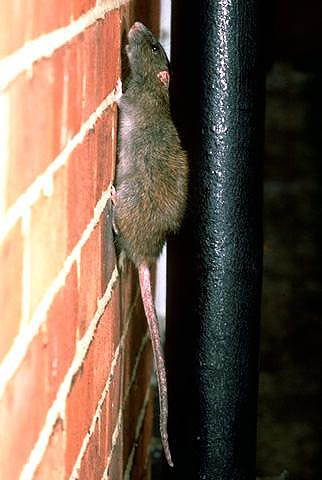 Mice and Rats: After rodent-proofing the building, any animals who (Note their use of “who” instead of “that.” R.G.) remain in a building or structure should be live-trapped and released outside. Poisons, sticky glue traps, and snap traps cause rodents and other animals intense suffering and agonizing deaths. Many hardware stores and humane societies carry live mouse and rat traps, but you can also make an effective, humane trap with a few items around your home:
Mice and Rats: After rodent-proofing the building, any animals who (Note their use of “who” instead of “that.” R.G.) remain in a building or structure should be live-trapped and released outside. Poisons, sticky glue traps, and snap traps cause rodents and other animals intense suffering and agonizing deaths. Many hardware stores and humane societies carry live mouse and rat traps, but you can also make an effective, humane trap with a few items around your home:
• Place dry oatmeal and peanut butter in a small plastic wastebasket in an area that is frequented by rodents. Provide them with a stack of bricks or books to climb up on, and they will jump in but won’t be able to climb back out.
• Check the trap often. The mice or rats will be hungry, thirsty, and frightened, and may die if left in the trap too long. Put on heavy gloves, take the garbage can outside, and release the rodents at least 100 feet from the building, in a park, wooded area, or meadow.
And people think I’m nuts. Two facts about rats: One, there is absolutely nothing for a rat to eat in a park, wooded area or meadow, and two, they possess a strong sense of smell. What rats smell is garbage. What they eat is garbage. What they will do is come back to houses with garbage cans. They will breed. America’s rat population is kept in check by human waste-food supply. When too many rats breed and their population exceeds the available food from garbage, their young die slow deaths from starvation. The humane thing to do is to take the rat(s) to a vet for euthanasia by injection, or, the economy being what it is, pop them in the head with a pellet gun.
As for mice, mice exist on the planet to be food for other animals. That’s it—that’s the entire intended scope of their existence. That they have proven useful in medical research to find cures to diseases was a lucky break. I didn’t have the heart to e-mail PETA with the news that every two seconds, a mouse encounters a frightening, agonizing, heart-pounding death via ingestion by an owl, fox, or snake.
High Spot Award
Perennial of the Year: Heuchera ‘Green Spice’
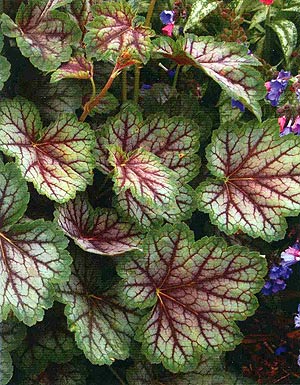 Unlike the exhaustive rules for judging trees, shrubs, garden books, websites and products, the directive found in the High Spot/Black Spot Award Judging Criteria Guidebook for selecting the Renegade Gardener Perennial of the Year is pretty simple, consisting in fact of a single sentence: “Base it on sexiness.”
Unlike the exhaustive rules for judging trees, shrubs, garden books, websites and products, the directive found in the High Spot/Black Spot Award Judging Criteria Guidebook for selecting the Renegade Gardener Perennial of the Year is pretty simple, consisting in fact of a single sentence: “Base it on sexiness.”
Clear then to understand why ‘Green Spice’ rode on top to a unanimous victory this year. It’s dashingly handsome. Achingly beautiful. And just plain hot. The seductive leaves are broad, medium to large for the genus, shapely, mildly ruffled, with a most beguiling, sensual combination of green edges, erotic silver/pewter inner coloring, and blood-red veins, coursing blood-red veins, throbbing blood-red veins, come, come hither, buy me, whip me, grow me in a pot.
I believe it flowers, right now I don’t remember, it must, late spring probably, the flowers are insignificant, and who cares? Breeders, we have enough Heucheras in the reddish-purple-marmalade range—this look is what was missing.
It’s a Terra Nova introduction from a few years back, and it’s proven itself reliably hardy to Zone 4 with very good performance through to Zone 9. Plants mound to a height of around nine inches with a width of sixteen inches or so. Best vigor and leaf color is achieved in part sun or filtered sun, though it’s quite shade tolerant. ‘Green Spice’ prefers well-drained soil that harbors some organic matter, with a pH range of 6.0-7.0.
Plant it in swaths at the base of shrubs and small trees, or pop a triangle of three ever so often along the front of the perennial bed. But by all means, have it.
High Spot Award
Best Photo Submitted By a Reader
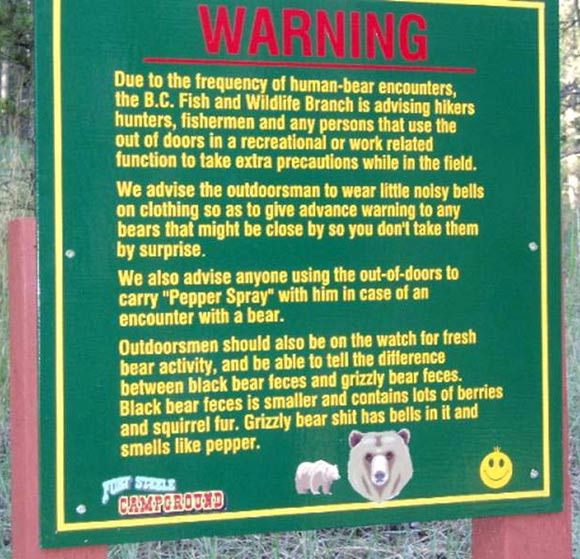
And now, ladies and gentlemen, this evening’s final award:
High Spot Award and Black Spot Award
Best Example That It’s Over: Actual Quote From Nursery Brand Manager
As you can tell, this year’s panel of award judges was hugely conflicted while trying to choose exactly what to award this sadly honest assessment of the current gardening marketing scene, and that was before the Irish coffee and fisticuffs broke out. It appeared in a 2008 issue of the trade publication, Grower Talks. Here is the exact quote uttered by the brand manager of a major American nursery during an interview with GT:
“The consumer today is buying by impulse. They don’t know plants. We know that from all the studies that have been done. The gardener is gone. The hobbyist is gone. Don’t overanalyze it. If you can improve your appearance at the point of sale, you’ll sell more stuff.”
There you have it, comrades—more heinous than any plastic flower, any service that paints your dormant, winter lawn green, even worse than the godawful, three-foot plastic waterfall that came to our attention during 2008. This is what the industry thinks of us.
The judges finally decided to award a High Spot Award based on sheer balls and honesty, while deciding that a Black Spot Award was equally merited, since it’s these same marketing idiots who have created the problem they now market to overcome. If you’d care to read a full treatise on the subject hinted at above, check out this piece by the Renegade Gardener that won the 2007 Garden Writers Association award for Best Article, Web Publication: Is Gardening Dead?
This concludes the 2008 Renegade Gardener High Spot/Black Spot Awards. I wish I had a funny story or one-liner with which to end this evening’s ceremony, but I don’t feel very humorous. It’s tough to look at all the work you’ve done, the hours you’ve put in over a twelve-year career as a garden writer, and realize that it was all for naught. Ah well, there’s always that unfinished novel staring at me from the shelf.
Last gardener to leave, please turn off the lights.
Don Engebretson
The Renegade Gardener
- The 2018 Renegade Gardener High Spot/Black Spot Awards January 5, 2019
- The 2017 Renegade Gardener High Spot/Black Spot Awards January 1, 2018
- The 2016 Renegade Gardener High Spot/Black Spot Awards January 1, 2017
- The 2015 Renegade Gardener High Spot/Black Spot Awards January 1, 2016
- The 2014 Renegade Gardener High Spot/Black Spot Awards January 7, 2015
- The 2013 Renegade Gardener High Spot/Black Spot Awards January 1, 2014
- The 2012 Renegade Gardener High Spot/Black Spot Awards January 4, 2013
- The 2011 Renegade Gardener High Spot/Black Spot Awards January 1, 2012
- The 2010 Renegade Gardener High Spot/Black Spot Awards January 1, 2011
- The 2009 Renegade Gardener High Spot/Black Spot Awards January 1, 2010
- The 2008 Renegade Gardener High Spot/Black Spot Awards January 1, 2009
- The 2007 Renegade Gardener High Spot/Black Spot Awards January 3, 2008
- The 2006 Renegade Gardener High Spot/Black Spot Awards December 20, 2006
- The 2005 Renegade Gardener High Spot/Black Spot Awards December 9, 2005
- The 2004 Renegade Gardener High Spot/Black Spot Awards January 1, 2005
- The 2003 Renegade Gardener High Spot/Black Spot Awards November 19, 2003
- The 2002 Renegade Gardener High Spot/Black Spot Awards October 31, 2002
- The 2001 Renegade Gardener High Spot/Black Spot Awards October 16, 2001
- The 2000 Renegade Gardener High Spot/Black Spot Awards October 20, 2000